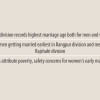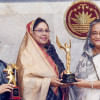Early Marriage: A contributor to “modern slavery” in Bangladesh?

Two recent reports depicting the state of human rights in Bangladesh point to some alarming statistics. The first report, the Bangladesh Bureau of Statistics' "Report on Bangladesh Sample Vital Statistics 2017"(RBSVS), came out in June 2018. Among its many findings, one relates to the prevalence of underage marriage for women. In 2008, the average age of marriage for women in Bangladesh was 19.1 and this climbed to 19.3 in 2012. Since then, there has been a downward trend, and the age hovered between 18.7 and 18.8 in 2015–2017. For men, the average age increased from 23.8 in 2008 to 26.2 in 2017. In sum, over the last five years, more women got married at a younger age while men's average age of marriage kept going up.
A second report, "The Global Slavery Index" published in mid-July by Australia's Walk Free Foundation (WFF), reveals that as many as 592,000 people could be living in "modern slavery" in Bangladesh. One can question the definition used by WFF to identify those who are enslaved, but it is a fair guess that if we conduct a more thorough survey, the number of our people who work as indentured labour will increase manifold. "The modern face of slavery can express itself in many forms: in the lives of domestic workers, bonded and forced labour in rural and urban areas, low-paying factory work, errand boys in offices, flower sellers at traffic junctions, tea boys in makeshift eateries and sex workers." (Lipika Pelham, New York Times)
In the case of Bangladesh, one of the factors contributing to "modern slavery" is the prevalence of forced and underage marriage of women. This connection between child marriage and slavery was strongly asserted by an earlier UN Commission for Human Rights (UNCHR) study. A 2014 UNCHR report entitled "Preventing and Eliminating Child, Early and Forced Marriage" reiterates that under certain circumstances, forced marriage leads to slavery-like practices and can amount to slavery under UN conventions on child, early, and forced marriage (CEFM).
Child marriage in Bangladesh has long been an acceptable practice, but it affects the two genders asymmetrically. Various surveys show that over 65 percent of women currently aged 20–24 were married before the age of 18, the legal age of consent. An international NGO reports that 20 percent of girls become wives before their 15th birthday. Ironically, the Bureau of Statistics' RBSVS indicates that "[The prevalence of] early marriage is gradually changing as an impact of enactment of laws, uplifting of female education, and participation of women in gainful employment and the technological innovation and changes in the society." However, there is little evidence to support this statement, and one needs to conduct further research to draw any definitive conclusion. Since the process of social changes is slow and requires sustained measures over time, it is too early to prove that education and employment for women by itself have the desirable impact on early marriage. The "National Multimedia Campaign for Ending Child Marriage" launched in July last year is therefore a step in the right direction, and the campaign laudably begins with the admission that "Bangladesh has one of the highest rates of child marriage in the world."
It is understandable that when parents, or their guardians, engage in organising, or conniving in underage marriage for a child, they do so for many reasons. However, very few of these adults realise that they are also participating in a practice that often leads to hard work, abuse, and sometimes slavery for the bride or groom, i.e. their loved ones. We all grew up with movies like "Balika Bodhu" or Satyajit Ray's "Samapti" based on Tagore's short story. In these fictional stories, the boy and girl grow up together in idyllic settings. However, for the average underage bride, in fact for the vast majority of them, life is anything but as carefree as depicted in these romantic stories. Economic hardship or social norms limit their freedom, liberty and education. Conservative societies or families often condemn these young newlyweds, mostly females, to many years of toil, parenthood, and servitude. And one could even classify this condition as bondage or slavery. Once again, to the outsider, these social mores and practices remain under the radar screen, and in the absence of trained social workers in the country, the health and welfare of the teens and young adults often remain hidden under the curtain of social taboos.
What do we do about this practice? It is expected that the strong support in our society for education will make a dent on the incidence of underage marriage. Data shows that 86 percent of women with no education were married before 18 years of age, compared to 26 percent of women who had completed secondary or higher education. There is also a correlation between location (rural/urban) and awareness of legal age limits. Forty-five percent of women surveyed in rural areas in contrast to 55 percent in urban areas were aware of the legal age of marriage.
Various measures adopted by this country and others to achieve the Sustainable Development Goals (SDG) will advance the cause of elimination of CEFM and underage labour exploitation. Many of SDG goals will promote access to education, gender equality, and access to reproductive resources, which are positively correlated with women's age at marriage and welfare. A recent study strongly articulates this nexus. "The practice of CEFM undeniably perpetuates patriarchy and gender inequality that further marginalise girls. It exacerbates poverty and the vulnerability of girls living in poverty. It has economic consequences, including limiting people's control over and access to economic assets and productive resources. Girls are prevented from forming social networks and accessing an education, and suffer from health and nutritional consequences. CEFM involves a lack of free, full, and informed consent; it limits bodily integrity and the enjoyment of childhood."
In the absence of social change, developing countries will witness an increase in child marriage. The United Nations Fund for Population Analysis estimates that over 100 million girls below the age of 18 will be married in the next decade. The consequences are dire. "Overall, the cultural practice of forced marriage places women at greater risk of exploitation, and the potential subjection to a life of servitude, financial bondage and sexual exploitation that comes with modern slavery," the WFF report says. One cannot overstress the need for targeted action to address the root causes, including ensuring the design and enforcement of legal measures that are rights-based.
Dr Abdullah Shibli is an economist, and Senior Research Fellow, International Sustainable Development Institute (ISDI), a think-tank in Boston, USA. His new book Economic Crosscurrents will be published later this year.

 For all latest news, follow The Daily Star's Google News channel.
For all latest news, follow The Daily Star's Google News channel. 








Comments